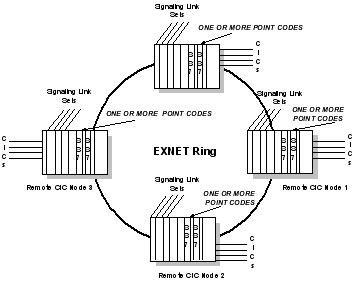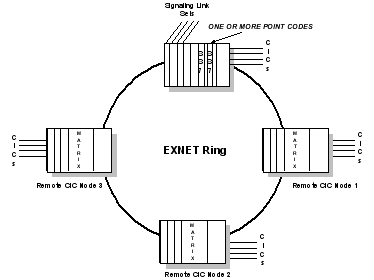
You are here: CSP Developer’s Guide: Common Channel Signaling > 3 SS7 over the EXNET Ring > SS7 over the EXNET Ring

Overview
The signaling stack for the SS7 protocol interfaces with another network via SS7 signaling links on the SS7 card. Each stack on each SS7 card in an EXNET Ring must have its own unique address, called a Point Code, assigned to the SS7 stack
Prior to SS7 over the EXNET ring, if there were four remote nodes in the system, each node would have a Point Code assigned for the SS7 stack and there would be at least four Point Codes on the ring Previous Methodology for Point Codes (Ethernet not shown) . To the network, each CSP appeared as a separate entity, and the CSP was not really functioning as a single SP. This reduced the efficiency in routing, particularly in defining address locations where connections have been made. This could have led to problems in data transfer and to time delays. Cost was also a major concern. Since each SP required separate signaling links, along with redundant links, the monthly lease costs became prohibitive.
The next figure shows the Point Code assignments before implementation of SS7 over the ring.
Figure 3-2 Previous Methodology for Point Codes (Ethernet not shown)

Conditions before implementation of SS7 over the ring included:
• One or more SP/nodes
• One or more Link Set per node
• One or two SS7 cards per node
Using SS7 Over the Ring with a Single Server Node
With SS7 over the ring, using only the Server Node for SS7 connections to the network, only one Point Code is required per Server Node. To the network, the CSP at the Server Node finally appears as a single SP.
In the new SS7 over the ring implementation, the capability exists to get a single link set to that external point. Instead of handling each signaling link differently, now all the links can be combined as one signaling link set, improving routing implementation and reducing monthly link lease costs.
Diagram
The next figure shows the Point Code assignments after implementation of SS7 over the ring:
Figure 3-3 SS7 Over the Ring Methodology for Point Codes in a Single Server Node (Ethernet not shown)

Conditions after implementation of SS7 over the ring on an SS7 card include:
• One per 4-node CSP
• Four per 7-node CSP
• One or more Link Set(s) per 4-node CSP; a minimum of Four Link Sets per 7-node CSP
• One or 2 card pair(s) per four-node CSP; a minimum of four card pairs per 7-node CSP
Using SS7 Over the Ring with Multiple Server Nodes
In a CSP system there can be multiple Server Nodes on the same EXNET ring, each with its associated remote nodes (CICs), for a maximum total of seven nodes. Each Server Node operates the same way as it does in the Single Server Node configuration. Control is limited to a maximum of four nodes comprised of one Server Node and three remote nodes (CICs).
This means that each Server Node appears as a separate or mini-network to the PSTN, and each Server Node continues to have its own unique Stack IDs, Point Codes, and remote nodes (CICs). A multiple node setup on the EXNET therefore contains four different Point Codes.
This feature does allow calls to be connected between two CICs that reside on different SS7 Server Node mini-networks, since all the Server Nodes are part of the same CSP system.
Redundancy is not affected.
A fault or matrix controller switchover on one Server Node in a multiple node system will not affect any node that is controlled by another Server Node in the same system.
• Each stack on each Server Node in a multiple node system must have a unique Point Code. No two stacks in the entire CSP system may share the same Point Code.
• Each remote (CIC) node must be controlled by one and ONLY one SS7 Server Node. Two Server Nodes should not be sharing control over CICs on the same remote node.
 Cantata strongly recommends that two Server Nodes not share control over CICs on the same remote node. It will cause unexpected results.
Cantata strongly recommends that two Server Nodes not share control over CICs on the same remote node. It will cause unexpected results.
Single Server Node Configuration
One to four stacks can be configured for each SS7 card or SS7 card pair that has been installed on the SS7 Server Node. This means there can be from one to four SPs configured, each with its own OPC. (Configuration of a 7-node ring is done the same way at each of the four Server Nodes.)
The next figure shows an example of a Single SS7 Server Node configuration:
Figure 3-4 SS7 Over the Ring with Ethernet and EXNET Connections

In the previous figure one node has been selected as the Server Node and used to command the SS7 resources and distribute and share them with the three remote nodes. No SS7 cards need to be installed into the CSPs on the remote nodes. Only the Server Node has the SS7 card or redundant pair. Voice channels (CICs) in all four CSP nodes are controlled from the Server Node.
Considerations that may affect the decision include:
• High availability
• Available capacity and accessibility for connecting signaling links
• Available capacity, particularly the number of slots, for SS7 cards and card pairs
All signaling links must terminate on the Server Node. In previous topologies with CSP, SS7 signaling links had to communicate with an SS7 card on every node to manage control of voice circuits.
L3P on the SS7 card(s) communicates with CSP Call Control on the active matrix controller cards of both local and remote nodes for call processing, using Ethernet communication paths (see previous figure).